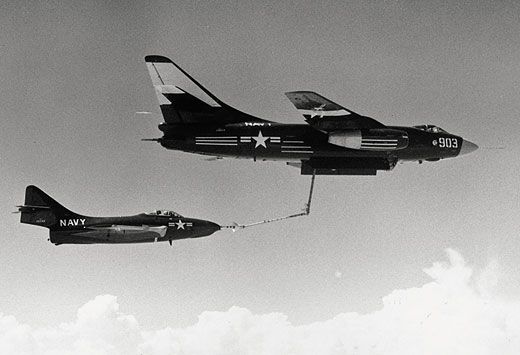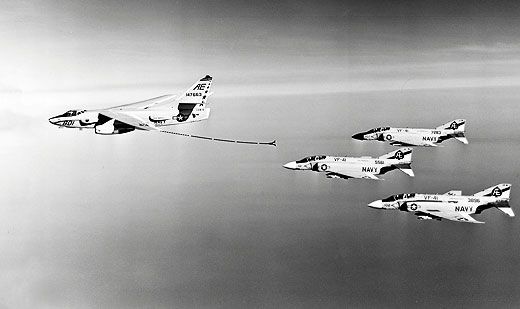Above & Beyond: Warner and the Whale
How we turned the A3D into a tanker
/https://tf-cmsv2-smithsonianmag-media.s3.amazonaws.com/filer/JJ11-Above-and-Beyond-1-FLASH.jpg)
In the mid-1950s, a naval officer in the Bureau of Aeronautics in Washington, D.C., with gold up to his elbows, took a hard look at the Douglas A3D Skywarrior, which would earn the nickname Whale, and thought: Hmmm. Here we have the biggest airplane ever to trap on a carrier—an airplane with an immense bomb bay. Pilots are flying a whole fleet of them around empty, theoretically honing their skills. Gotta do something about that. So he dictated a note to his chief. “Pressurize the bomb bay and make it a VIP transport. Or how about a tanker?”
His note started the paper mill rolling, and eventually a letter of intent went to Douglas Aircraft. The legendary designer Ed Heinemann balked at loading up his Skywarrior with refueling equipment, but the Navy insisted.
At the Douglas test facility at Edwards Air Force Base in California in 1956, flight test engineer Warner Lowe and I had just investigated the high-angle-of-attack engine stalls on A3Ds coming off carrier catapult shots. We were cooling our heels, wondering what fiasco would be tossed at us next, when we were told to go to Douglas in El Segundo, California. An A3D had just been configured into a tanker there, and Warner and I had to fly it to Edwards. For a couple of weeks, the test facility made various tweaks to it.
The tanker had a four-inch-diameter hose with a refueling basket attached, wound on a large reel in the rear of the bomb bay. On the first test flight, we extended hose and basket to its full 60-foot length and listened for what the pilot of our Lockheed T-33 chase plane would say about its stability. Before he could open his mouth, the hose and basket whipped in a large circle and snapped off. Doing his best to sound like Chuck Yeager, Chase said, “Gents, y’all’s hose and basket are on their way down. Looks like a big ol’ snake flyin’ through the air. Better luck next time. See ya.” He did a slow roll and flew off.
The Navy decided to try a “flying pipe” system of rigid tubing that hung beneath the A3D. Though it proved somewhat stable, during one plug with a Grumman F9F, part of the tubing broke off from the Whale but didn’t disconnect from the Grumman. The F9F pilot was very unhappy about landing on the lakebed with several feet of tubing hanging off the nose, and didn’t want anything more to do with us. (Let him grumble. There was always another young test pilot eager to log plug time.) That was the end of the tubular refueling system.
Various sizes of hose, drogue, and basket were then tried. We attempted hooking up with another A3D: That seemed to work after a fashion.
The Navy wanted a pilot new to refueling to try our system. I was an old World War II fighter pilot (P-39, P-40, and P-51), and before the A3D flights had never even heard of a probe. So I was chosen. Although I had been the tanker pilot, I would now pilot another A3D and hook up with the A3D tanker.
The system was still a little unstable, and we were in light turbulence. While Warner, as copilot, wore a big grin, I edged toward the basket at 15,000 feet and eased the probe into it while it danced its little jig. When I thought I had it, I added a little power to make the plug—and missed. I shaved off some power, backed out, and set up to try again. Warner was now chuckling. I gave him a dirty look and again eased the probe into the basket. Bingo! A solid plug. I held it for a few turns, climbs, and descents at various speeds. I grinned back at Warner. “Piece of cake.”
I had recently spent a week aboard the USS Forrestal and had ridden along on four A3D catapult shots and traps. Now I thought about the black of night with rain and more turbulence, and stopped grinning.
All our connect tests had been fuel-less—and would stay dry until we were absolutely sure of the system. After dropping many hoses and baskets on the lakebed, accompanied by snide remarks from Chase, we figured we were about ready to get wet.
Things were going smoothly when for some reason, with the hose fully extended and the refueler aircraft standing by, the system shut off. No retraction, no extension, nothing. We had considered this possibility during the planning stage: We had a cutting device called the guillotine that could be activated from the cockpit. Now, even the guillotine wouldn’t cooperate.
“Hold it,” Warner said. “I’ll go aft and see what I can do.” He couldn’t fit into the bomb bay wearing a parachute, so he unbuckled and left the chute in his seat. “Now look,” he said, “I’ll have to walk on the bomb-bay doors to get to the reel, so for Christ’s sake, stay away from that bomb-bay door switch.”
We depressurized, and away went fearless Warner, chuteless. I told ground control what was going on. I supposed they just shrugged their shoulders.
In a few minutes Warner came on the intercom. “I’m at the reel and it looks okay. But to get where I have to, I’ll be standing on the doors. Got it?” I confirmed, then glanced at the bomb-bay doors switch and light.
Suddenly I froze. The bomb-bay doors light came on—the doors were open. I prayed to hear Warner’s voice.
Then, the sweetest words ever to come over an intercom. “Holy Christ, can’t you see my chute in my seat? What in hell are you trying to do?”
He told me later that before putting two feet on the doors, he used one foot to tap them. Nothing happened, so, holding fast to a structure, he started to stand with both feet when the doors popped open. Fortunately he had a good hold while staring open-mouthed at the lakebed 15,000 feet beneath us.
I told him I hadn’t even come close to the switch—“Must have been a glitch.” He didn’t answer. He was watching Edwards Air Force Base slide by below. Finally: “I’m going to chop the damned hose off with the axe and come forward.” I felt the hose and drogue release, and Warner slid back in the cockpit. He buckled into his parachute and said only, “Let’s go home.”
Chase reported another hose whipping through the air. “More junk for the lakebed.”
After I landed, we headed for engineering. Warner uttered not a word. He wasn’t even sweating. I was soaked. I tried to convince Warner I hadn’t touched the switch. No response.
Engineering found a short circuit in the electrical system that powered the hydraulics to operate the doors. The remaining test flights went off without a hitch. But there seemed no way to get Warner back on my side. I even gave him a bottle of Black Label.
The tanker program proved quite successful. A few dozen A3s were converted to tankers, and some of those were given jamming capability. The tankers served in Vietnam and flew until they were replaced by Grumman KA-6D Intruders. In addition to carrying bombs, A3Ds were also configured as VIP transport as well as radar surveillance aircraft.
With time, Warner softened, and even bought me a drink. But I always felt some sort of disconnect. I had to remember what it must have been like, coming that close to a horrible fall and certain death.

